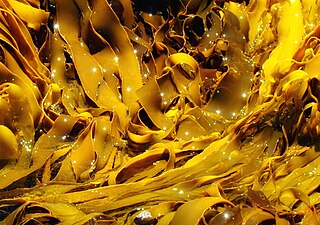
Algae are any of a large and diverse group of photosynthetic, eukaryotic organisms. The name is an informal term for a polyphyletic grouping that includes species from multiple distinct clades. Included organisms range from unicellular microalgae, such as Chlorella, Prototheca and the diatoms, to multicellular forms, such as the giant kelp, a large brown alga which may grow up to 50 metres (160 ft) in length. Most are aquatic and lack many of the distinct cell and tissue types, such as stomata, xylem and phloem that are found in land plants. The largest and most complex marine algae are called seaweeds, while the most complex freshwater forms are the Charophyta, a division of green algae which includes, for example, Spirogyra and stoneworts. Algae that are carried by water are plankton, specifically phytoplankton.

Phycology is the scientific study of algae. Also known as algology, phycology is a branch of life science.

The green algae are a group of chlorophyll-containing autotrophic eukaryotes consisting of the phylum Prasinodermophyta and its unnamed sister group that contains the Chlorophyta and Charophyta/Streptophyta. The land plants (Embryophytes) have emerged deep in the Charophyte alga as a sister of the Zygnematophyceae. Since the realization that the Embryophytes emerged within the green algae, some authors are starting to include them. The completed clade that includes both green algae and embryophytes is monophyletic and is referred to as the clade Viridiplantae and as the kingdom Plantae. The green algae include unicellular and colonial flagellates, most with two flagella per cell, as well as various colonial, coccoid and filamentous forms, and macroscopic, multicellular seaweeds. There are about 22,000 species of green algae, many of which live most of their lives as single cells, while other species form coenobia (colonies), long filaments, or highly differentiated macroscopic seaweeds.

AlgaeBase is a global species database of information on all groups of algae, both marine and freshwater, as well as sea-grass.

Bornetella is a genus of green algae in the family Dasycladaceae.

Akuammine (vincamajoridine) is an indole alkaloid. It is the most abundant alkaloid found in the seeds from the tree Picralima nitida, commonly known as akuamma, comprising 0.56% of the dried powder. It has also been isolated from Vinca major. Akuammine is structurally related to yohimbine, mitragynine and more distantly Voacangine, all of which are alkaloid plant products with pharmacological properties.

Peyssonnelia is a genus of thalloid red alga, named after naturalist Jean-André Peyssonnel (1694–1759) It includes the algae commonly known as rumoi-iwanokawa, mayoi-iwanokawa and akase-iwanokawa. Specimens can reach around 20 cm in size. Peyssonnelia produces tetraspores.

Pericine is one of a number of indole alkaloids found in the tree Picralima nitida, commonly known as akuamma. As with some other alkaloids from this plant such as akuammine, pericine has been shown to bind to mu opioid receptors in vitro, and has an IC50 of 0.6 μmol, within the range of a weak analgesic. It may also have convulsant effects.

Red algae, or Rhodophyta, are one of the oldest groups of eukaryotic algae. The Rhodophyta comprises one of the largest phyla of algae, containing over 7,000 currently recognized species with taxonomic revisions ongoing. The majority of species (6,793) are found in the Florideophyceae (class), and mostly consist of multicellular, marine algae, including many notable seaweeds. Red algae are abundant in marine habitats but relatively rare in freshwaters. Approximately 5% of red algae species occur in freshwater environments, with greater concentrations found in warmer areas. Except for two coastal cave dwelling species in the asexual class Cyanidiophyceae, there are no terrestrial species, which may be due to an evolutionary bottleneck in which the last common ancestor lost about 25% of its core genes and much of its evolutionary plasticity.

Sphenopholis is a genus of North American and Hawaiian plants in the grass family.
Nitida saga or Nítíða saga is a fictional late medieval Icelandic romance saga thought to have been composed in Iceland in the fourteenth century. This saga is about a maiden-king named Nitida, who rules over France, and who is pursued by kings and princes from such faraway places as Constantinople, India, and a place the saga calls the Land of the Saracens. It is thought to be a direct response to Klári saga: in Klári saga, the main female protagonist, Serena, is brutally punished for her initial refusal to marry the hero Klárus, whereas the heroine of Nitida saga is portrayed much more favourably. Ethnicity, travel, and geography play important roles in the saga, and questions of gender and power, while magic, trickery, and deception are also prominent.

Passiflora nitida, the bell apple, is a tasty, but relatively unknown passion fruit. It is similar to P. laurifolia, with orange-yellow fruits that have a sweet, succulent pulp. It is a fast-growing tropical vine. Its flowers are blue and red, a bit like P. laurifolia and P. quadrangularis. The fruits grow up to 4 centimetres (1.6 in). The exact hardiness in unknown, but it is tropical and should be protected from prolonged temperatures below 50–55 °F (10–13 °C). It is not frost hardy. Passiflora nitida is the cousin of almost all the Passiflora species like P. actinia, P. flavicarpa, P. loefgrenii and so on. Its propagation is by seeds. The fruits are eaten fresh and reportedly quite good in flavor. The bell apple is a native to the Amazon jungle region. Passiflora nitida is also a useful fruit in a drink called Purple Passion. Passiflora nitida has one of the widest geographic ranges. It grows in the tropical lowlands from Costa Rica in the north and French Guiana in the northeast, through wide parts of Brazil.

Cenarrhenes is a monytypic genus in the family Proteaceae containing the single species Cenarrhenes nitida, known as the Port Arthur plum or native plum. Cenarrhenes nitida is an evergreen shrub to small tree endemic to the rainforests and scrublands of western Tasmania. It bears white flowers in late spring followed by the development of fleshy fruit.

Akuammicine is a monoterpene indole alkaloid of the Vinca sub-group. It is found in the Apocynaceae family of plants including Picralima nitida, Vinca minor and the Aspidosperma.

The Barrier Reef chromis, also known as the yellowback puller or shining puller, is a species of damselfish in the family Pomacentridae native to the east coast of Australia. It is a small fish with a yellowish-brown dorsal surface separated by a dark stripe from its silvery flanks and underside.

Rivularia is a genus of cyanobacteria of the family Rivulariaceae.

The wych elm cultivar Ulmus glabra 'Nitida' [:'shining', an allusion to the smooth upper surface of the leaves], the smooth glossy-leaved wych, was described by Fries from specimens collected by P. C. Afzelius in 1841 on the island of Stora Karlsö, Sweden, as Ulmus montana nitida, in Novitiae Florae Suecicae: continuatio, sistens Mantissam III: 20 (1842). The Novitiae Florae Gotlandicae (1844) confirmed U. montana f. nitidaFr. as present on the islands of Stora Karlsö and neighbouring Lilla Karlsö off Gotland, Sweden, but did not report it from Gotland proper. A Stora Karlsö specimen from the Herbarium E. Fries is preserved in the Botanical Museum of Uppsala. The tree was listed by Rehder as U. glabraHuds. f. nitida (1915), a designation adopted by Krüssmann (1984), the latter copying Rehder's 'Norway' provenance error.

Bornetella sphaerica, commonly known as the spherical turtle shell, is a species of marine alga in the Dasycladaceae family. It is found in the tropical Indo-Pacific region, the type-location being Sorong, Irian Jaya, Indonesia.
















